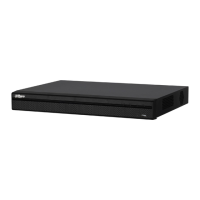
Do you have a question about the Dahua DH-XVR5416L-X and is the answer not in the manual?
| Video Output | 1 HDMI, 1 VGA |
|---|---|
| Video Input | 16 channels |
| Video Compression | H.265+/H.265/H.264+/H.264 |
| Storage Capacity | Up to 16TB |
| Network Interface | 1 RJ-45 port (10/100/1000 Mbps) |
| Power Supply | DC 12V |
| Audio Input/Output | 1 input, 1 output |
| Smart Functions | Motion Detection, Smart Search |
| HDD Bays | 2 |
| Max HDD Capacity | 10TB |
| HDMI Output | 1-channel, up to 4K resolution |
| VGA Output | 1 channel, Resolution: 1920 × 1080; 1280 × 1024; 1280 × 720 |
| USB Interface | 2 USB 2.0 |
| Power Consumption | < 15W (Without HDD) |
| Operating Temperature | -10°C to +55°C (14°F to 131°F) |
| Operating Humidity | 10% to 90% RH |
Essential steps for securing the system against cyber threats.
Optional measures to further enhance network security and protection.
Specifies the necessary environmental and operational conditions for the device.
Details safety precautions related to the electrical aspects of the device.
Guides users on verifying all included components upon receiving the device.
Provides step-by-step instructions for installing a Hard Disk Drive into the device.
Details the components and indicators located on the front panel of the device.
Describes the various ports and connectors available on the rear panel of the device.
Illustrates common connection diagrams for setting up the device with peripherals.
Explains how to connect video and audio sources and outputs to the device.
Guides through the initial setup process, including booting and device initialization.
Covers how to view live video feeds from connected cameras and control the display.
Details how to connect and control PTZ (Pan-Tilt-Zoom) cameras.
Provides instructions for adjusting various image and encode settings for connected cameras.
Explains how to add, initialize, and manage remote devices like cameras.
Covers settings for manually or automatically recording video streams.
Guides users on searching, playing, and managing recorded video files.
Covers configuration of various alarm inputs, outputs, and event detection settings.
Explains features like SMD, Face Detection, and IVS for intelligent video analysis.
Covers configuration of network settings like TCP/IP, Wi-Fi, PPPoE, and DDNS.
Manages user accounts, groups, ONVIF users, and security questions.
Details settings for managing HDD, recording schedules, quotas, and FTP storage.
Covers general device settings, maintenance, security, and upgrade procedures.
Guides on how to view device version, log, network, HDD, and channel information.
Steps to connect the device to a network for web access.
Instructions for accessing the device's interface via a web browser.
Procedures for resetting the admin password if forgotten.
Troubleshooting steps for issues related to the DVR not powering on.
Solutions for problems encountered when trying to log into the client software or web interface.
Provides guidelines for regular maintenance to ensure optimal device performance.
Explains the nature of electrical surges and their potential impact on electronic devices.
Discusses different earthing methodologies used in system design for compatibility.
Details the pinout and connection scheme for cross-connecting RS-232 and RJ45 ports.
Provides information on the pinout and connection scheme for straight-through cables.











